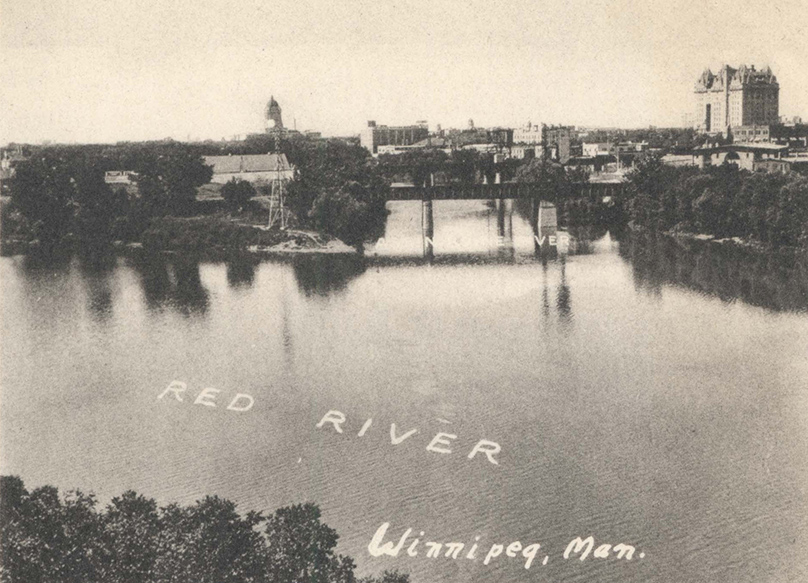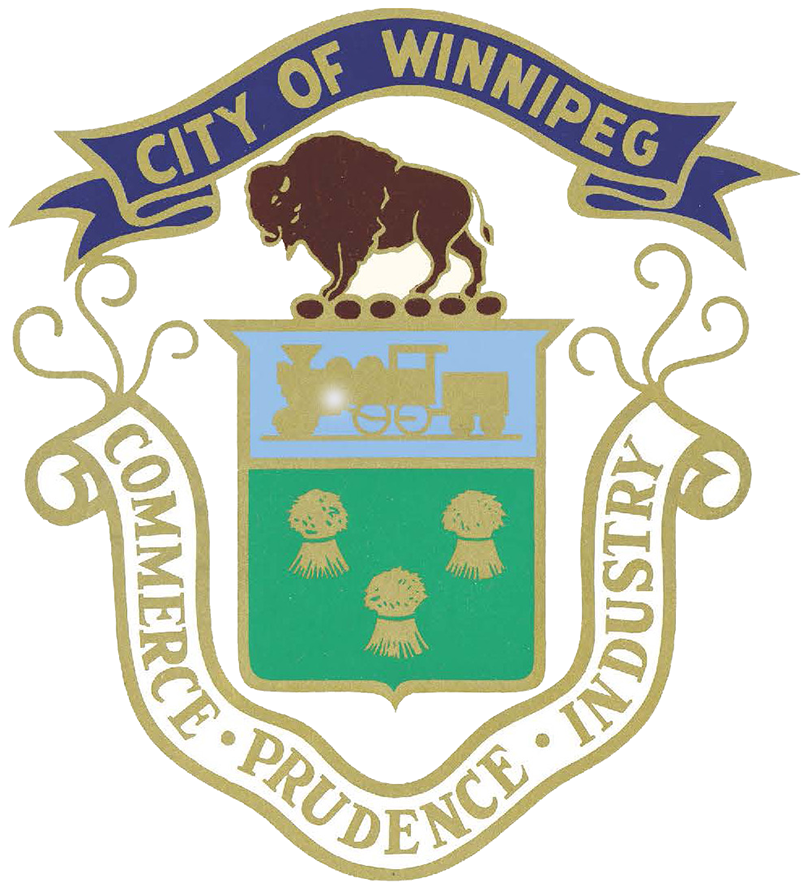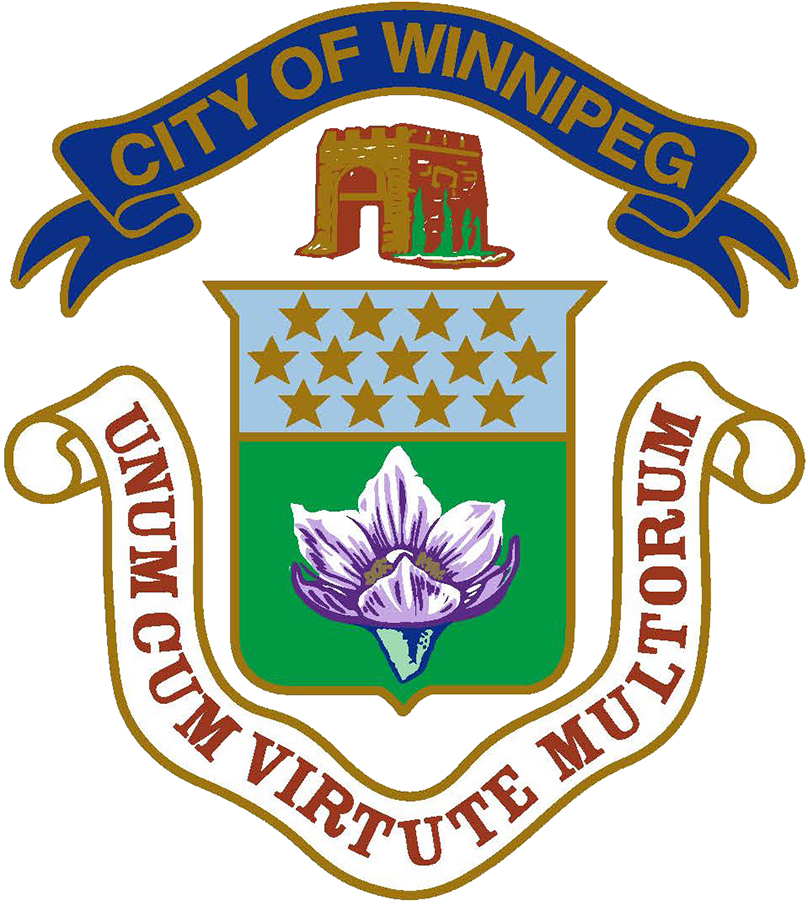What follows is a brief overview of Winnipeg’s history. It is by no means complete. To learn more, we recommend exploring a wide range of sources, including oral histories, books, archives, museums, and more.
Winnipeg was founded where the Red and Assiniboine rivers meet, near the geographic centre of North America. Winnipeg has long been an important place for community and gathering as well as a commercial, transportation, and cultural hub. It is the largest city in Manitoba and the provincial capital.
“Winnipeg” comes from the Cree name for the lake 65 kilometers to the north (Lake Winnipeg), meaning “win” for muddy and “nippee” for water. It is sometimes translated to “murky water”.

Indigenous Homeland
Winnipeg is located in Treaty One Territory, the home and traditional lands of the Anishinaabe (Ojibwe), Ininew (Cree), and Dakota peoples, and in the National Homeland of the Red River Métis. Many Indigenous peoples call Winnipeg their home, including Inuit from the north and Indigenous peoples from territories across Turtle Island. The City of Winnipeg recognizes the importance of First Nations, Métis, and Inuit peoples to the founding of our city. Each brought culture, values and vision – contributions that continue to be important to our shared future.
For thousands of years, Indigenous peoples lived and thrived on this territory. They developed distinct Nations connected by languages, customs, traditions, laws, and stories. The first peoples of this land built settlements and economies based on hunting, fishing, agriculture, and trade. Oral history and archaeological evidence show The Forks, the site where the Red and Assiniboine rivers join, has been an important meeting place for Indigenous peoples for at least 6,000 years. In recognition of this history, The Forks was designated a National Historic Site of Canada in 1974. The arrival of settlers saw the creation of treaties and the treaty relationship. That relationship continues to this day, although settlers didn’t respect that the treaties were created with the intent of sharing land and resources.
This land and the larger area of the Red River Valley also saw the rise of the Red River Métis Nation. The Manitoba Métis Federation, the National Government of the Red River Métis says, “the Red River Métis is made up of Métis Citizens” and is, "defined by a common ancestry, identity, culture, social and kinship relationships and, among other things our history.” In addition to developing their own language, Michif, the Red River Métis were historically active in the fur trade and farmed on river lots in the Red River Valley. The Métis invented and used Red River carts to transport their goods across the North-West on trails that later became Winnipeg streets like Main Street, Portage Avenue, and Pembina Highway.
Red River Settlement
In the days of the fur trade, The Forks was an important area for commerce and settlement. Fur trade companies built several forts throughout the area starting in 1738. These included Fort Rouge, Fort Gibraltar, Fort Douglas, and Fort Garry. By the 1800s, the Hudson’s Bay Company was looking to strengthen its position in the territory. It granted Thomas Douglas, the Earl of Selkirk, a large tract of land to create the Red River Settlement. In 1812, Scottish agricultural settlers, known as the Selkirk Settlers, started arriving in Red River. This made existing tensions between the Hudson’s Bay Company and its rival the North West Company even worse. That’s because the North West Company already had a presence in the area. The conflict peaked in 1816 with the Battle of Seven Oaks, also known as the Victory at Frog Plain. The North West Company, led by Cuthbert Grant, successfully defended Métis rights at this battle, making it a significant moment in Métis history.
The two fur trading companies ended their conflict in 1821 when they merged under the Hudson’s Bay Company name. The Council of Assiniboia was created at that time to administer law and order in the Red River Settlement and surrounding area. Local community leaders, who were predominantly Métis, managed much of the area’s business and affairs. When Canada purchased the vast area known as Rupert’s Land and the North-Western Territory from the Hudson’s Bay Company without consulting the Métis and other residents, the attempted land transfer was interrupted by the Red River Resistance in 1869-1870. Leaders of the Resistance, most notably Louis Riel, were instrumental in creating the Province of Manitoba in 1870. They also helped shape the terms by which the area became part of Canada.
Gateway to the west: “Commerce, prudence, and industry”
In 1862, several stores opened in the unincorporated village of Winnipeg, which emerged from within the Red River Settlement. More than a decade later, on November 8, 1873, the Legislature passed An Act to Incorporate the City of Winnipeg, officially making Winnipeg a city and adopting its name. The first election was held the following year on January 5, 1874. The first City Council meeting took place later that month on January 19, 1874. This is why the city has historically commemorated 1874 as its anniversary year.
At the time of incorporation, Winnipeg consisted of about five square kilometers. The city’s southern and eastern boundaries were marked by the Red and Assiniboine rivers. Present-day Maryland Street, Notre Dame Avenue, and McPhillips Street marked its western limits, while Burrows Avenue west of Main Street and Aberdeen Avenue east of Main Street defined its northern boundary. Significant extensions to the boundaries were made in 1875, 1882, 1906, 1962, and 1972.
The first City of Winnipeg crest & motto
Winnipeg’s first City Council adopted the City’s original crest and the motto: “Commerce, prudence, industry.” The crest included a locomotive to represent the coming of the railroad, and sheaves of wheat to symbolize agriculture and Winnipeg’s position as the gateway to the west. The crest also showed a bison, a strong symbol of the prairies, looking west and indicating “progress” westward.

Rapid growth
City leaders at the time were intent on making Winnipeg “the Chicago of the North.” A railway connection eventually reached a point across the river from Winnipeg in 1878. On July 1, 1886, the first Canadian Pacific Railway train arrived within city limits. The railways supported the grain industry in the west and increased migration to the area, ushering in a period of rapid growth. In 1874, City assessors estimated a resident population of just 1,869 people. By 1924, the city had grown to 194,850 people.
Not everyone benefited equally from this period of rapid growth. Many Indigenous peoples were displaced. Closely connected with the City’s incorporation was the Reign of Terror against the Red River Métis, which saw numerous Métis people forced to leave their lands and hide their identities out of fear for their lives. Some Métis families established road allowance communities like Rooster Town on the outskirts of Winnipeg. The Indian Act and pass system restricted First Nations people with status to reserves. Many Indigenous people travelled to or were sent to Winnipeg for health care or schooling at places like the Assiniboia Indian Residential School in the city’s River Heights neighbourhood. Winnipeg’s growth also affected First Nations communities outside of the city, such as Shoal Lake 40 First Nation. Members were impacted when Winnipeg selected Shoal Lake as a water source and built the aqueduct between 1914 and 1919. Additionally, rising social, economic, and class divisions within the city led workers to organize the Winnipeg General Strike in 1919.
1950 flood
A larger and more populated settlement meant that flooding, a natural occurrence in the area, had the potential to cause more damage. This was the case with the 1950 flood, which was particularly severe and led to the evacuation of around 100,000 people. It was largely in response to this event that the Red River floodway was built between 1962 and 1968.
Unicity: “One with the strength of many”
In the 1960s, the City of Winnipeg was one of 13 municipalities in the Greater Winnipeg area. The Metropolitan Corporation of Greater Winnipeg (also known as Metro) was established to coordinate services and planning among the local governments (1960-1971). In 1972, the municipalities amalgamated, creating the unified City of Winnipeg. The municipalities consisted of:
- City of East Kildonan
- City of St. Boniface
- City of St. James-Assiniboia
- City of St. Vital
- City of Transcona
- City of West Kildonan
- City of Winnipeg
- Town of Tuxedo
- Rural Municipality of Charleswood
- Rural Municipality of Fort Garry
- Rural Municipality of North Kildonan
- Rural Municipality of Old Kildonan
- Metropolitan Corporation of Greater Winnipeg
The new unified City Council consisted of 50 councillors, one from each of the 50 wards and a mayor elected from the city-at-large. In 1977, further legislation reduced the number of wards to twenty-nine. Further reductions were made in 1989, 1991, and 1992. The current City of Winnipeg Charter was passed by the Manitoba Legislature in 2003, which outlined further changes to the structure of municipal government.
A new City crest and motto
In 1973, City Council adopted a new crest for Winnipeg and a new motto, “UNUM CUM VIRTUTE MULTORUM”, Latin for “One with the strength of many”. The current crest depicts 13 gold stars and the Fort Garry Gate, which represents the area’s heritage and the 13 municipal governments, including Metro, that were unified. The blue background depicts Winnipeg’s clear blue skies. Below the sky, a prairie crocus upon a plain green field represents Winnipeg’s location on the prairies.

Winnipeg today
Winnipeg is currently home to a thriving arts and culture scene. Such arts organizations as the Royal Winnipeg Ballet (est. 1939), Winnipeg Symphony Orchestra (est. 1947), and the Royal Manitoba Theatre Centre (est. 1970) are located in the city. Many festivals have taken root here over the years, including Festival du Voyageur (est. 1969), Folklorama (est. 1970), Winnipeg Folk Festival (est. 1974), Winnipeg Fringe Theatre Festival (est. 1988), and Winnipeg International Jazz Festival (est. 1989). Galleries, libraries, archives, museums, and other sites like the Winnipeg Art Gallery and Qaumajuq, Manitoba Museum, Canadian Museum for Human Rights, National Centre for Truth and Reconciliation, Hudson’s Bay Company Archives, and The Forks ensure that Winnipeg remains a place of meeting, dialogue, and learning.
Today, Winnipeg continues to be a major commercial, transportation, and cultural centre. It is a multicultural city, enriched by the diverse peoples from across the world that have chosen to make it home. Winnipeg currently has the largest Indigenous population in Canada. Thanks to community leaders and partnerships, it is an important site of reconciliation. Winnipeg’s Indigenous Accord, the Red River Métis National Heritage Centre, Naawi-Oodena, Agowiidiwinan Centre, and Wehwehneh Bahgahkinahgohn are among the many initiatives advancing reclamation and reconciliation in Winnipeg.
The vision of a unified city is still a goal we’re striving for. It’s something that the people and communities of Winnipeg must do together in the spirit of reconciliation and with hope for our shared future.
